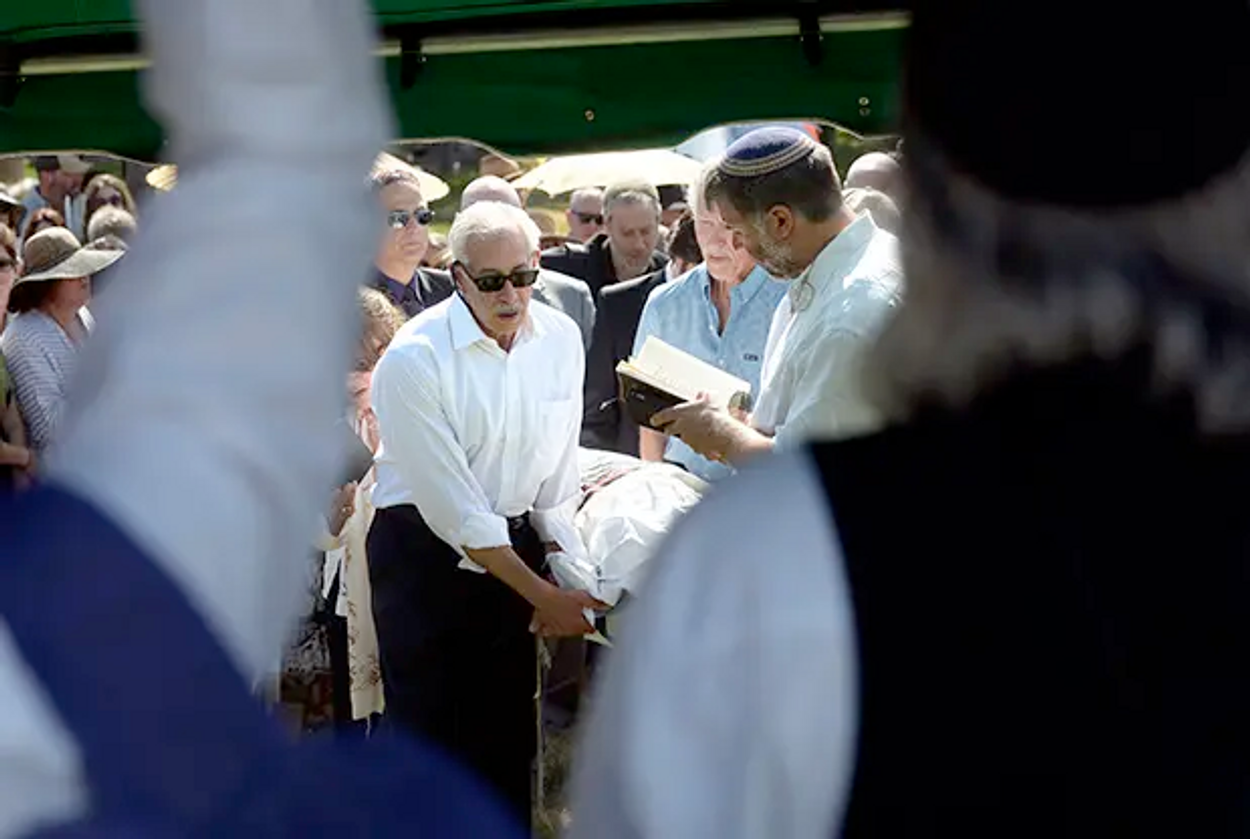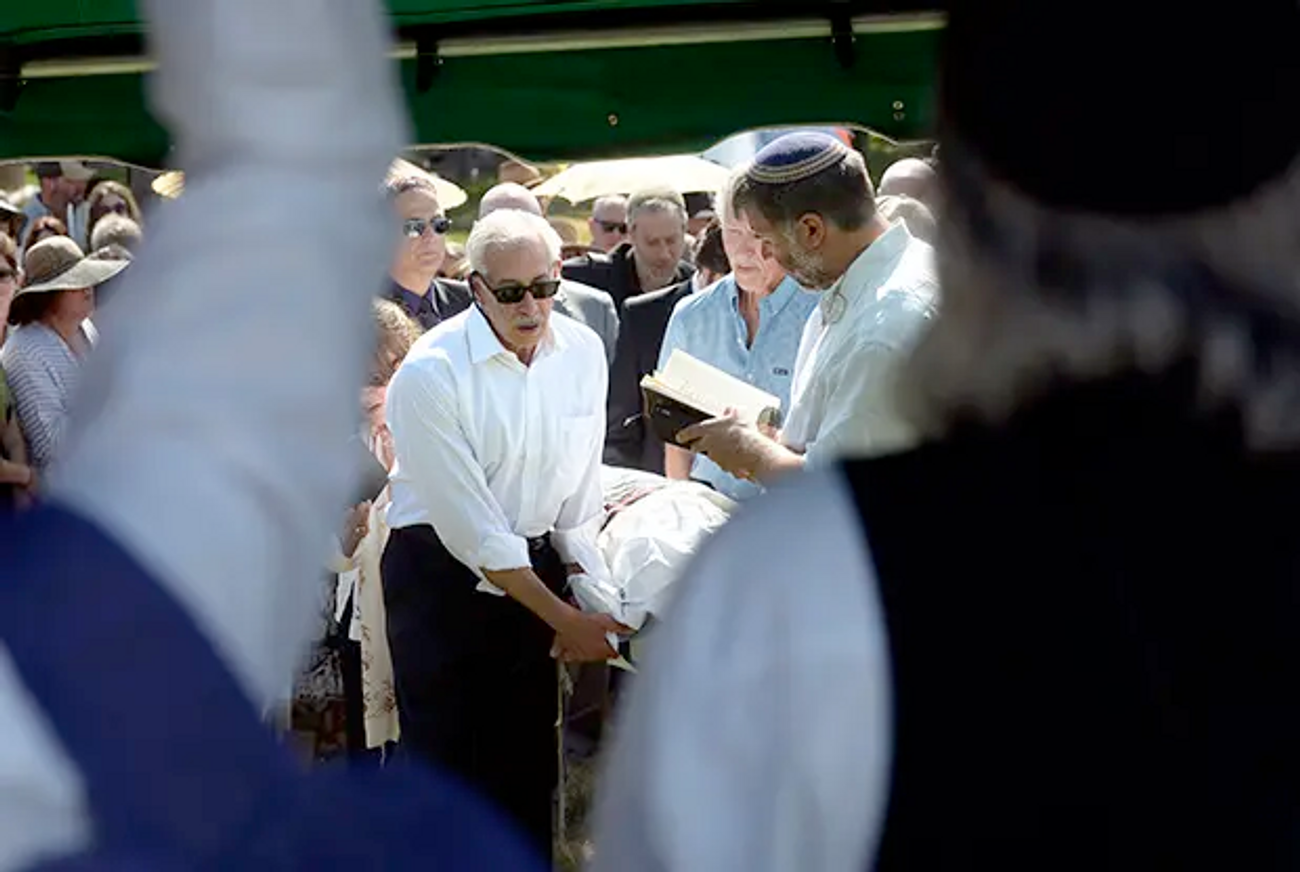Remembering Rabbi Zalman Schachter-Shalomi
An unconventional funeral for the founder of the Jewish Renewal movement




His leaving was as unconventional as his teaching and his life.
Rabbi Zalman Schachter-Shalomi wanted no casket, no plain pine box. For his funeral, which was held on the fourth of July, he wanted to be clothed in his white kittel, enfolded in his father’s tallis, sprinkled with ashes brought from Auschwitz, then shrouded in white linen and lowered directly into the earth near his home in Boulder, Colo.
He wanted the ashes buried with him in honor of the millions who’d died without receiving “a holy burial.”
It felt wrenching to shovel dirt onto his body. It also felt a privilege.
I’d been working with Reb Zalman since 2009, when he’d surprised me by asking to have a series of conversations about what he called the December Project, hoping I might write about it. “When the last notes of your life’s symphony are being played,” he said, “it’s such a wonderful and holy moment—I want to make sure people will be able to meet that with serenity and joy. That’s what the December Project is about.”
I signed on, mainly to spend time with Reb Zalman. We met every Friday at his home for two years, and our talks sprawled over a wide span of seemingly unrelated topics. I kept trying to get him to define the December Project, and he would answer with a story, a song, a memory, until at last, a pearl would emerge that startled me with its brilliance.
He recounted how his father had gathered the family and fled from Austria shortly after the country was annexed by Hitler. They traveled by night across fields, borders, and oceans, being imprisoned twice, until they finally landed, penniless, in New York in 1941.
Zalman had met members of Chabad in Belgium, and after arriving in New York, went to see their leader, Yosef Yitzhak Schneersohn, the sixth Lubavitcher Rebbe, in Brooklyn. When Zalman, then 16, told the harrowing story of their escape, the Rebbe arranged for Zalman’s parents to work as furriers and for Zalman and his siblings to enter a yeshiva. Zalman walked away from the meeting with tears flowing. “I felt that I had been fully seen—more than at any time in my life. And fully loved.”
That’s how I felt each week when I left Reb Zalman’s home—fully loved, and grateful. He was constantly deluged with requests for his counsel and blessing. He knew he could help people with his insights, which usually came from an unexpected angle, but also because “the time I spend with people tastes good; it gives them endorphins. There’s a carry-away of love, and if that’s not there it won’t work.”
Zalman spoke about how he began moving beyond the Chabad community and developing Jewish Renewal. He was curious and fearless. He started reading philosophy and psychology books that were forbidden by Chabad. He meditated with Buddhists and prayed with Christians, took part in Native American and Sufi rituals, and began incorporating elements of other traditions in his Jewish practice.
Reb Zalman was unpredictable; he never gave the same speech or teaching twice, never conducted a Passover seder the same way. He led seders with ultra-Orthodox Hasids that lasted till dawn, a seder with Catholic bishops and nuns where they reenacted the Last Supper, and a seder where people took four puffs of marijuana instead of drinking four cups of wine.
At a seder of his I attended in 2012, he began by gathering 13 of us in his living room and asking, “What do you feel, if you didn’t get it tonight, it wouldn’t be a seder?” One person said, “the unexpected.” Another wanted to feel connected to everyone present, and another wanted to “ask the questions we’re holding in our souls, instead of reciting the traditional four questions.”
“Amen,” Reb Zalman said, and by the end of the evening, we’d asked our questions and felt heard and nourished.
Reb Zalman believed that the “exit moment” from this life is important. He quoted Woody Allen, who’d said, “I don’t mind dying, I just don’t want to be there when it happens.”
Reb Zalman countered, “I do want to be there. I want to watch the last breath going out and whisper the Shema. I want to merge back with the infinite…like a drop in the greater ocean.”
He died on the morning of July 3, while he was sleeping. His wife, Eve Ilsen, said, “Who knows if he whispered the Shema in his sleep?”
He’d repeated it so many times in his life, preparing for that moment, that I’m inclined to believe he did.
Sara Davidson is the author ofThe December Project: An Extraordinary Rabbi and a Skeptical Seeker confront Life’s Greatest Mystery, which chronicles her weekly conversations with Rabbi Zalman Schachter-Shalomi, the late founder of the Jewish Renewal movement.